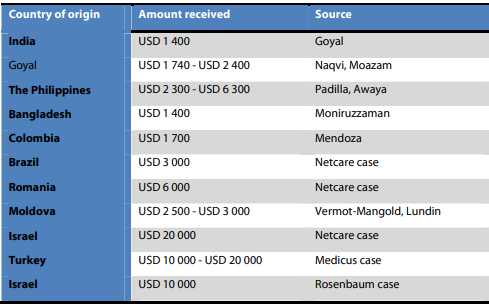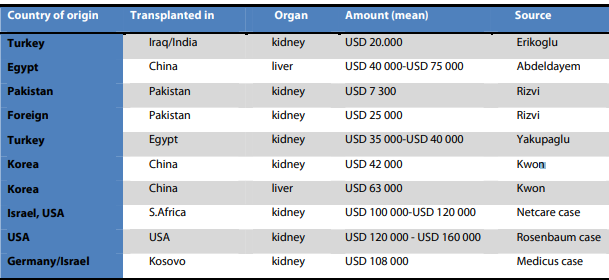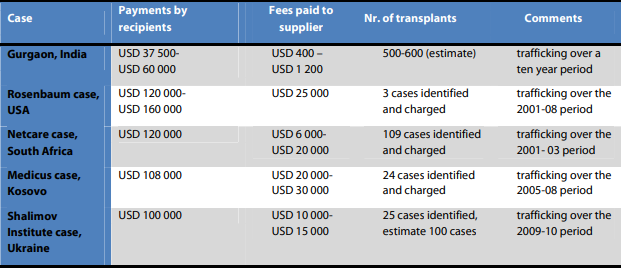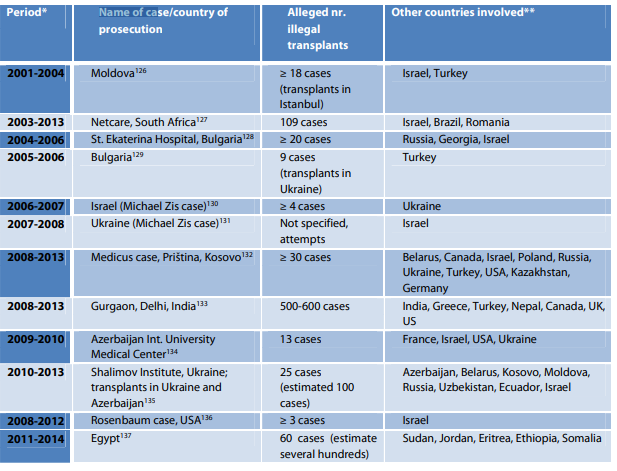Outline
Thesis Statement: The essay will argue that the best way to track and stop human organ trafficking is by following the money.
The paper uses information from international organizations and peer-reviewed scholars to strengthen its claims. It follows the following outline and uses various sources to determine the best method to track and stop perpetrators of the trade.
- Provide a background on the illegal human organ transplant trade (Meshelemiah & Lynch, 2019; United Nations, 2018).
- Describe the stakeholders that make the trade possible (Meshelemiah & Lynch, 2019; Thompson, 2020).
- Outline the potential targets for the trade (United Nations, 2018; Meshelemiah & Lynch, 2019).
- Highlight those that obtain monetary benefits from the trade (Meshelemiah & Lynch, 2019).
- Describe various challenges that make it hard to stop the trade (United Nations, 2018; Meshelemiah & Lynch, 2019).
- Outline existing measures against human organ trafficking (Howard & Cornell, 2016, Meshelemiah & Lynch, 2019).
- Recommend new strategies to help track the money using evidence from credible scholars (Heinl et al., 2019).
- Conclude by summarizing important points.
Illegal Human Organ Trafficking
Human organs play a key role in saving human life. More than 114000 individuals in America are on the organ waitlist, and new individuals are added every ten minutes (Meshelemiah & Lynch, 2019). Existing organs can only meet about 10% of the demand (United Nations, 2018). The lengthy waitlist and the dreaded outcomes push people to be involved in illegal organ transplants. There is no correct data regarding the trade, though it seems to be on the rise due to considerable profits. It is worth noting that this trade does not involve willing donors rebelling from cultural values for charity. The victims are often unwilling, uninformed, illiterate, and homeless, making it a human rights violation. The trade’s persistence shows that law enforcement’s existing measures are not efficient. The essay proposes that the best way to detect and stop the trade is to focus on the financial transactions instead of implementing laws that define the boundaries of legal human donation.
Stakeholders
The trade involves a complicated network of parties that make organ harvesting possible. The first person in the network is a broker, the intermediary between the buyer and the seller. This individual also coordinates the entire trade, makes strategic decisions, and is often the first person that the recipient contacts. The broker can be a hospital director, surgeon, or tissue-matching laboratory. Another party is the local recruiter, who identifies the supplier. Doctors are also involved in the operation because they have to perform removal and transplant operations. Arguably, these individuals are the most important aspect of this trade. Other parties involve custom officers, health administration officers, and officials dealing with visas and travel documents. Corruption plays a key role in manipulating these individuals especially in red areas such as China (Thompson, 2020). The trade is complex, which may explain why law enforcement finds it hard to stop its spread despite its popularity.
Target Groups
The trade’s victims are often vulnerable people across the globe. The targets are frequently individuals from poor populations and societies (United Nations, 2018). Rare circumstances exist where donors are given anesthesia and wake up without their organs (Meshelemiah & Lynch, 2019). Brokers usually reside in the same communities or ethnicities among marginalized communities, making it easier to build relationships. For vital organs like the heart, they promise to take care of the donor’s family. It gets worse the victims do not receive compensation for their donated organs (United Nations, 2018). China is recognized a notorious for the trade, while most recipients are often from America (Meshelemiah & Lynch, 2019). Law enforcement cannot monitor the target groups due to the broad scope; hence they should use another angle.
Money
It is indisputable that the main aim for organ trafficking is financial gain instead of providing safe and high-quality medical care. The perpetrators do not care for the donor’s health, who may die during or after the operation procedure. Their main concern is the recipient who provides payment for their services and can refer other wealthy clients. Money is protection, and the trade’s profitability may explain why there is little risk for prosecution (Meshelemiah & Lynch, 2019). Reports estimate that the trade generates more than $600 million in annual profits (Meshelemiah & Lynch, 2019). The amount of money paid to suppliers varies across the globe, as seen in Figure 1.
Patients who intend to seek the services of illegally obtained organs expect to be charged a substantial fee for such operations. According to Figure 2, the price ranges from $100000 to $200000. Recipients pay for transplant packages, documents, and accommodation. Finally, available data on profits generated by the trade is not comprehensive and does not accurately provide information concerning this operation. However, Figure 3 highlights that brokers are better positioned to receive the lion’s share of the profit. The immense cash flow sustaining this operation shows that law enforcement has a chance to stop the operation by following the money.



Challenges to Stop the Trade
Various challenges make it harder for the authorities to stop the trade. The medical field and specialists have played an essential role in maintaining the industry. Ambulance staff, first responders, doctors, and medical institutions are deeply involved in the trade (United Nations, 2018). Statistics show that more than 114000 transplants occurred in approximately 190 nations (Meshelemiah & Lynch, 2019). It is worth noting that other organizations have also contributed to sustaining the trade. Examples include insurance agents, religious institutions, and travel agents. Another challenge is that it is hard to determine the trade’s correct extent because its clandestine nature makes it possible to have reliable data. These obstacles make it harder for existing strategies to stop this vice.
Existing Measures
The existing measures against the trade are legislative; hence not instrumental in efficiently detecting and stopping the vice. America has 26 laws that prohibit human organ trafficking (Meshelemiah & Lynch, 2019). These legislations explain the constituents of being dead, consent for organ donation. In 1984, America legislated the National Organ Transplant Act (NOTA), which illegalized the purchase or sale of organs. A task force was set up to enforce this legislation (Health Resources and Services Administration, n.d.). Despite these legislations and subsequent measures, America still leads as a trafficked organ recipient (Meshelemiah & Lynch, 2019). International laws have also been put in place to limit the vice. In 2008, the Declaration of Istanbul was developed and passed by 150 representatives from 78 nations (Meshelemiah & Lynch, 2019). Reports show that nations that adopted this policy successfully minimized the trade (Meshelemiah & Lynch, 2019). The World Health Organization has also established ethical donor transplants principles to prevent corrupt personnel from promoting the trade (Howard & Cornell, 2016). Still, these legislations do not help to identify and stop the corrupt parties involved in the trade.

Recommendations
The best way to track down and stop all involved parties is for law enforcement to be keen on money laundering indicators. It is cumbersome for banks to monitor all financial transactions connected to organ trafficking, but some indicators can level the playing field. These signs may be ineffective on their own but depict suspicious behavior when combined. The first indicator is wire transfers to organizations in notorious locations with medical-based names (Heinl et al., 2019). Another one is payment from philanthropic institutions and medical tourism sites. There are also potentially ill banking clients transacting considerable funds with several companies or charities before traveling. It is worth noting that it is legal to obtain an organ in some countries. However, such transactions may be illegal in their citizenship country. This form of intelligence gathering on financial transactions will help law enforcement determine those involved in the trade and stop them.
Conclusion
In summary, the illegal trade of human organs can be stopped if regulatory authorities follow the money. The target groups are individuals from poor backgrounds like refugees, the homeless, illiterate, and other vulnerable groups. The main stakeholders are the brokers, recruiters, medical personnel, and corruptible officers. The complex criminal network promotes the trade’s survival and makes it hard to stop the perpetrators. This trade generates billions in profits, and potential remedies should target the money. Various obstacles that have made it harder to stop the trade include insufficient data that makes it hard to quantify the trade’s extent and an inadequate contribution from law enforcement. Law enforcement can detect and stop this trade by following various money laundering indicators. Perhaps the essay’s findings may spark future research to focus on how following the money can help stop this trade.
References
Health Resources and Services Administration (HRSA). (n.d.). Selected statutory and regulatory history of organ transplantation.Web.
Heinl, M. P., Yu, B., & Wijesekera, D. (2019). A framework to reveal clandestine organ trafficking in the dark web and beyond. Journal of Digital Forensics, Security and Law, 14(1). Web.
Howard, R. J., & Cornell, D. L. (2016). Ethical issues in organ procurement and transplantation. Bioethics-Medical, Ethical and Legal Perspectives (pp. 123-144). IntechOpen.Meshelemiah, J. C. A., & Lynch, R. E. (2019). The cause and consequence of human trafficking: Human rights violations. The Ohio State University Pressbook.
Meshelemiah, J. C. A., & Lynch, R. E. (2019). The cause and consequence of human trafficking: Human rights violations:The Ohio State University Pressbook.
Thompson, A. (2020). China’s illegal organ trade: from executed prisoners to organ tourism to falun gong. West Virginia University Historical Review, 1(1). Web.
United Nations (UN). (2018). Global report on trafficking in persons. United Nations Office on Drugs and Crime. Web.